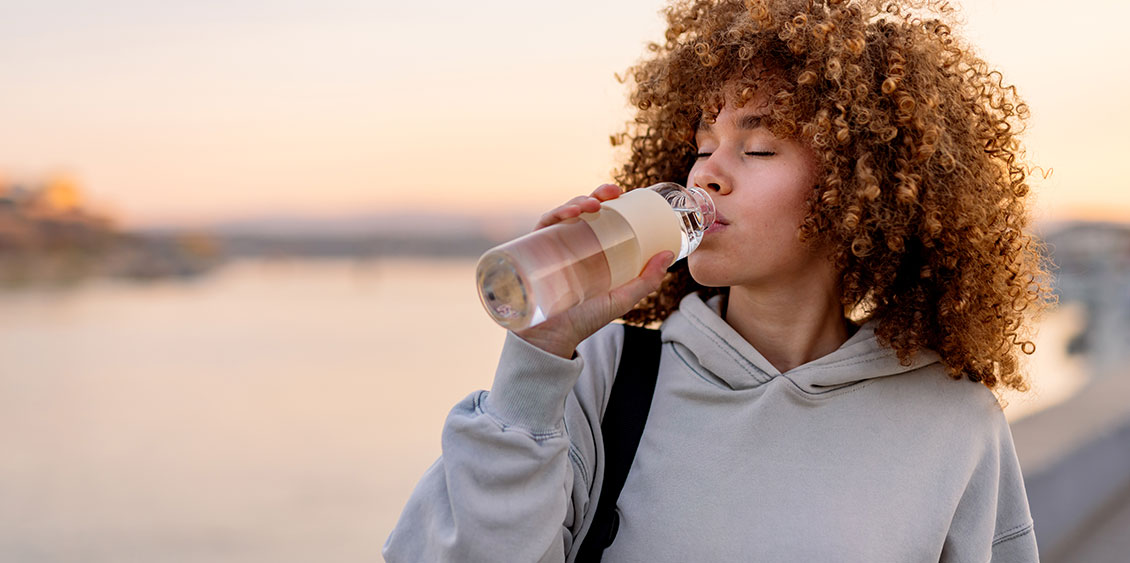Drinking water is essential, and becomes even more vital as we age. But sometimes we forget to drink enough, especially when we don’t feel thirsty. When this happens, our bodies become unbalanced—though the effects may not be obvious at first.
This practical guide has been designed to help you stay on track with hydration, step by step. It addresses the most frequently asked questions about dehydration, and will help you adopt good habits, especially during intense exercise and in hot weather. We’ve also included some tasty recipe ideas to make sure you get enough fluids throughout the day.

What is dehydration?
Dehydration is what happens when you lose more fluids than you drink. It can occur as a result of intense heat, physical exertion, fever, or even certain medications. You can become dehydrated without realizing it, especially if your body is weakened or less reactive.
Some people are more at risk of dehydration:
- Seniors, whose thirst signals are reduced with age
- Children, who become dehydrated more quickly than adults
- Pregnant women, who have increased fluid needs
- Active people, who lose fluids when they sweat
Did you know? Water is essential to all our body’s vital functions:
- The brain is about 75% water
- Muscles are 70% to 80% water
- Blood is over 90% water
- Bones are 20% to 30% water
Dehydration is not to be taken lightly. If you notice any signs, don’t hesitate to ask your pharmacist for advice.
Your skin can become dehydrated too. For practical advice on keeping your skin hydrated and to find out which creams are best for your skin type, read our article: How to tell the difference between dry and dehydrated skin.
Signs and symptoms of dehydration
The first signs may seem fairly harmless (fatigue, dry mouth, and headaches) but they shouldn’t be ignored. By catching these signs early, you can keep the situation from progressing to severe dehydration. Here are the different stages of dehydration:
Mild dehydration
- Sudden thirst
- Dry mouth or lips
- Tiredness
Moderate dehydration
- Dizziness
- Darker or less frequent urine
- Persistent headaches
- Nausea or vomiting
Severe dehydration
- Confusion or disorientation
- Accelerated heart rate
- Fainting
As soon as these signs appear, it’s important to take a break, sit down, and drink water or a rehydration solution. Important: The consequences of dehydration can be serious. If symptoms persist or worsen, consult a health care professional as soon as possible.
Avoid sunstroke this summer with advice from our specialists. Read our article: 8 useful tips to avoid sunstroke.
Why does dehydration cause cramping?
When your body’s dehydrated, it loses not only water, but also essential minerals such as sodium and potassium. This imbalance can disrupt proper muscle function, leading to sudden or painful cramps, especially after strenuous physical activity or in hot weather. Staying well hydrated helps keep your muscles relaxed and prevents uncomfortable cramping.
How long does it take to resolve dehydration?
How long dehydration lasts depends on its severity and how you respond to it. Mild dehydration can be resolved in a few hours with adequate fluids. More severe cases can take longer, especially in the elderly. The important thing is to act at the earliest signs to prevent the situation from worsening.
How does dehydration impact your health?
When your body lacks water, everything slows down. Your memory becomes less sharp, your movements less precise. You may find it harder to digest food, sleep, or even concentrate.
In more vulnerable people, the effects can be more serious: they’re at greater risk of falling, developing a urinary tract infection, becoming exhausted, or experiencing low blood pressure. For people with chronic illnesses like diabetes or hypertension, dehydration can lead to complications from their medication and may aggravate certain symptoms. Don’t hesitate to ask your pharmacist for advice on how to manage your medication if you are dehydrated.
How can you prevent dehydration?
When it comes to prevention, there’s no magic formula. But incorporating a few simple changes into your routine can make all the difference.
Start your day with a glass of water. Keep a bottle of water nearby, in your bag or on the table. Drink regularly, even if you aren’t thirsty. Drink more often when it’s hot outside, or if you’re more active than usual.
Diet can also help. Certain foods and dishes are rich in water: cucumbers, melons, strawberries, oranges, lettuce, soup, fruit purées—all these foods help you stay hydrated while adding variety.
Most importantly, adjust your fluid intake according to your age, your activity level, and the seasons. Consistency is what matters most.
How do I rehydrate quickly?
If something seems off—that is, if you feel dizzy, weak, or confused—you must act immediately. Sit down in a quiet spot. Drink small sips of water. In addition to water, certain homemade and commercially available rehydration solutions can help, especially if you are severely dehydrated.
If symptoms persist, consult a health care professional right away. Mild or severe dehydration may require a specific treatment.
Pedialyte alternative: an effective home recipe Rehydration solutions, available in pharmacies, can help prevent dehydration. Here’s a simple and effective homemade alternative: Simply mix water with a pinch of salt, a sprinkle of sugar, and a few drops of lemon juice. This drink helps recharge the body with electrolytes. It’s a gentle and effective way to hydrate, especially if you’ve lost a lot of fluids.
How much should you drink daily to stay well hydrated? For dehydration, the recommendation is to drink the equivalent of a glass of water (or water-based drink) every 15 to 30 minutes, depending on your body’s tolerance. Drinking large quantities will not help: it’s better to take it slow and steady. If you’ve lost a lot of fluids (due to heat, fever, or diarrhea), you may want to consult your pharmacist to determine the right quantity.
Tasty ways to stay hydrated
Although water is the best option, there are simple ways to add some flavour and variety throughout your day all while getting enough fluids.
🧃 Dilute your juice with an equal amount of water (or sparkling water) and add sliced citrus fruits.
🪴 Add cucumber slices or mint leaves to your water.
🫐 Add crushed blueberries and a few basil leaves to a tall glass of sparkling water.
🍵 Brew white or green tea, let it cool, then add berries or lemon.
🍉 In a blender, purée some watermelon cubes. Pour in a tall glass and mix in sparkling water or iced green tea.
🧊 Put lots of ice cubes in your smoothies or iced coffee—decaffeinated, ideally!
❄️ Insert popsicle sticks in watermelon slices and freeze. This is a cool treat that’s sure to please everyone!
🍇 Freeze grapes: they’re like one-bite sorbet bombs!
Drinking enough is a simple gesture you can do every day to protect your health. It helps you think more clearly, digest more easily, and have the energy to do the things you love.
So always keep your water bottle handy. Take a break and listen to what your body is telling you. And if you have any questions, your pharmacist is here to help.
Last updated on June 18, 2025
Other articles that might interest you

